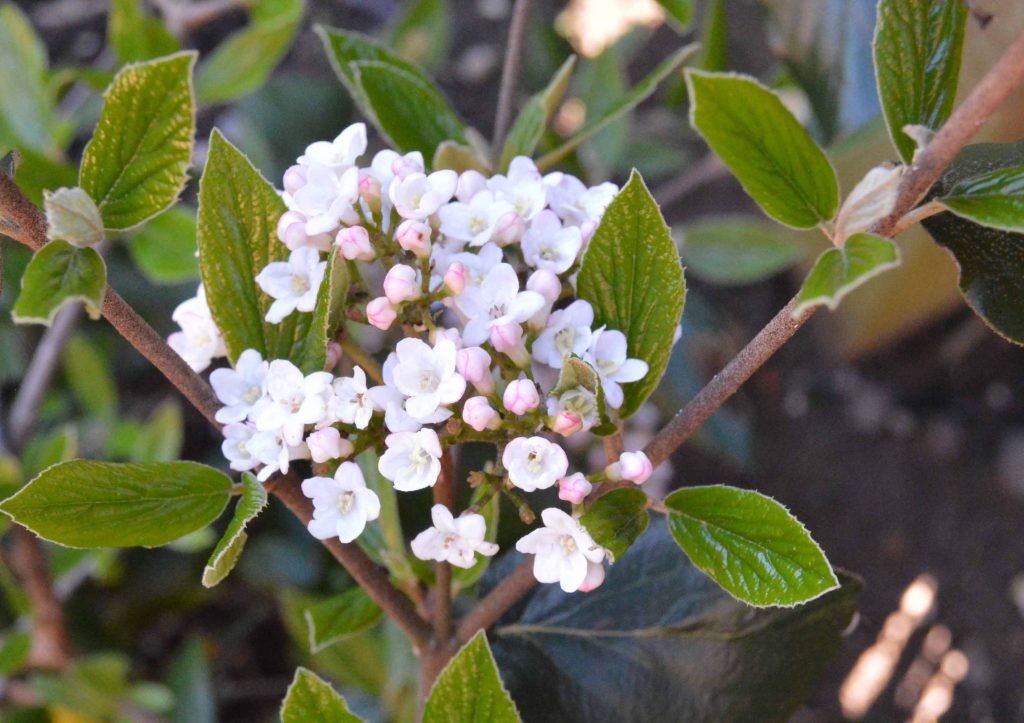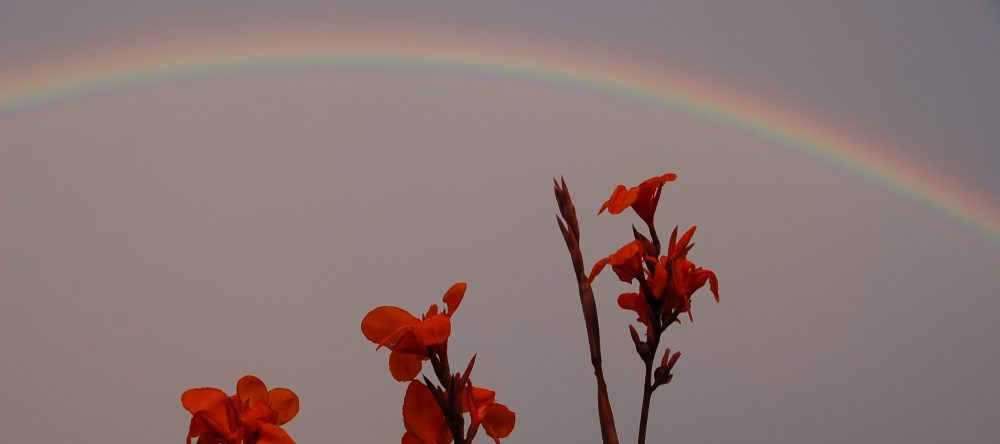The weather may still feel cold to me but, encouraged by the occasional day of sunshine, many of the plants are breaking into growth and into bloom. In the mini orchard, the plum tree is first off the mark, and full of blossom, which bodes well for a better crop than last year’s three plums (and one of those was rotten!)

The damson isn’t very far behind (so perhaps we’ll get some damsons this year), and the buds are about to burst on both of the apples, and both of the pears. It could be a good year for blossom.
In this exposed, rural location in North Shropshire, Pieris are a martyr to late frosts. But despite the cold winter, during which they sustained some damage, in terms of the new growth, it’s so far, so good…

The dainty white flowers are reminiscent of lily-of-the-valley, and the new shoots range from pink to bright red (and then brown, if caught by the frost). Here’s a random daffodil peeping through the evergreen canopy…

We’re well furnished for narcissus, of many varieties. Some precede our time. Others, like this clump of N. ‘Thalia’, were planted by us; spending their first year displayed in pots, and then being planted out into the beds to naturalise…

This Viburnum x burkwoodii is ahead of most shrubs, but then it is classed as semi-evergreen, which means it hangs on to some or all of its leaves, depending on how harsh the winter is. The new leaves are a lovely fresh, vibrant green. The flower clusters are pretty, but their main attribute (which I’m sorry I can’t share with you) is the beautiful scent they produce…

I’ve never been a fan of Skimmia, perhaps because so often when you see them in gardens they’re leggy and sparse, with yellowing leaves. But I have to admit this specimen, moved from the centre of the garden into our little woodland, is looking good…

Another plant I’ve taken a long time to come around to is Bergenia (elephants Ears). You need to regularly cut off the dead and dying leaves, or they look scrappy. You’ll often find them harbouring large colonies of snails (curiously though, these don’t seem to adversely affect the plants). And I’m not such a fan of the magenta-flowered varieties. But they are one of the few truly evergreen perennials. They’re one of the best ground cover plants too, doing a great job in suppressing weeds. The large, fleshy leaves are actually quite attractive – almost tropical. They’re evergreen (as previously stated) and yet the leaves also show autumn tints. And the flowers arrive at a time when few other perennials are in bloom.

This is one of the few white-flowered varieties, B. ‘Bressingham White’ (the clue’s in the name!) Seen from our kitchen window, I have to admit these are the perfect, pretty spring flowers.
Of all the perennials, these Ligularia (the evocatively named L. dentata ‘Midnight Lady’) are well advanced…

They like lots of moisture, so should be at home in the bog garden by the pond. I extended the pond liner into this area, punctured it with a fork, put a layer of slate chippings over it, and then put the topsoil back in. Even this wasn’t enough last summer, in 36 degrees and prolonged drought. Let’s hope for a better growing season this year (ideally nice and warm, but without the drought and extreme temperatures). I plan to tidy them up and cut out last years flowering spikes this weekend.
Naturalised tulips are beginning to bloom now too. This is ‘Purissima’…

I don’t much like the colour of these primulas, but they were in the garden already, and I couldn’t bring myself to throw them away…

We do have a few of the native yellow ones too. The rabbits got in and ate all the flowers, but so far my efforts to bolster the fencing have kept them out, and the primulas have pushed out new blooms.
One downside of rabbit-proof fencing is that it also excludes hedgehogs from the garden, which is a great shame. I want to encourage endangered wildlife, including hedgehogs. But I’m not prepared to sit back and watch the garden I’m lovingly creating be wrecked by rabbits (however cute they may be – and believe me, the two baby rabbits we watched playing in our woodland were unbelievably cute).
The last thing I want to share with you is this amazing little alpine plant, which has been flowering pretty much right through the winter, with the help of some occasional dead-heading. I have to admit when it comes to alpines, there are big gaps in my knowledge, so I can’t tell you what it is. Just when you might have thought it was exhausted, it doubles its efforts. Its been joined, in a happy accident, by a little patch of aubretia (not sure where that came from!)…

text & images © graham wright 2023
